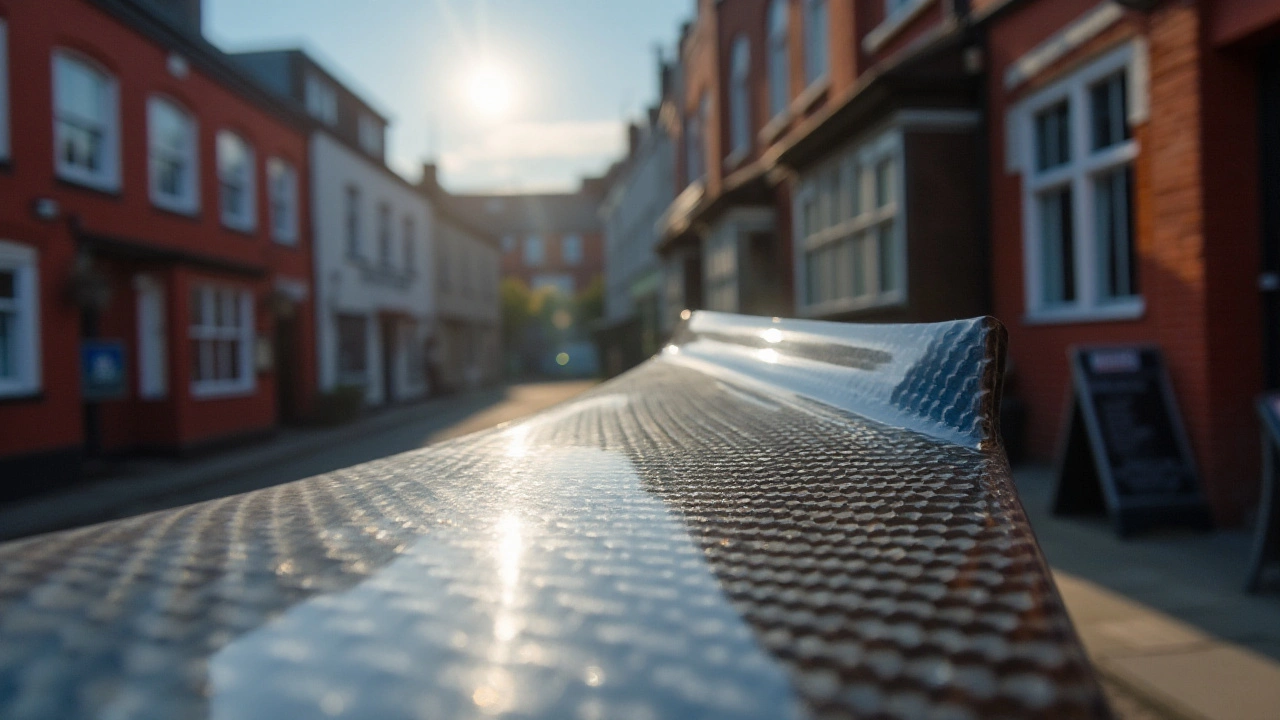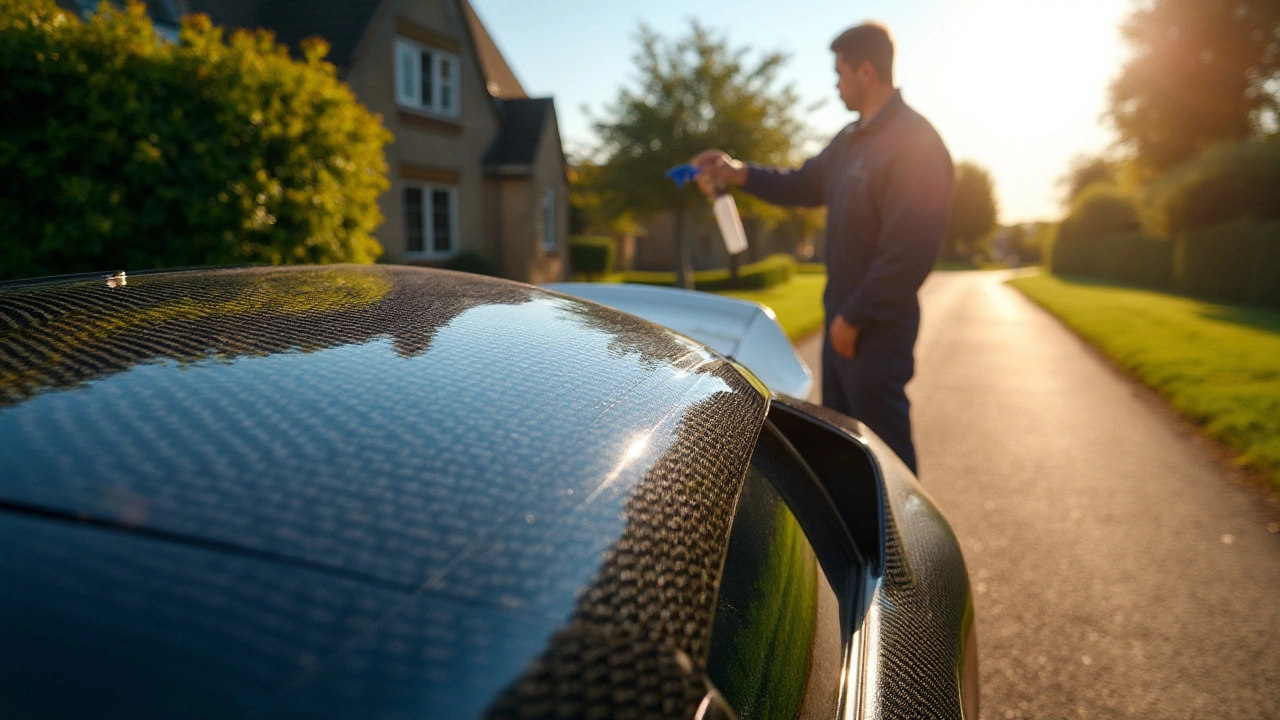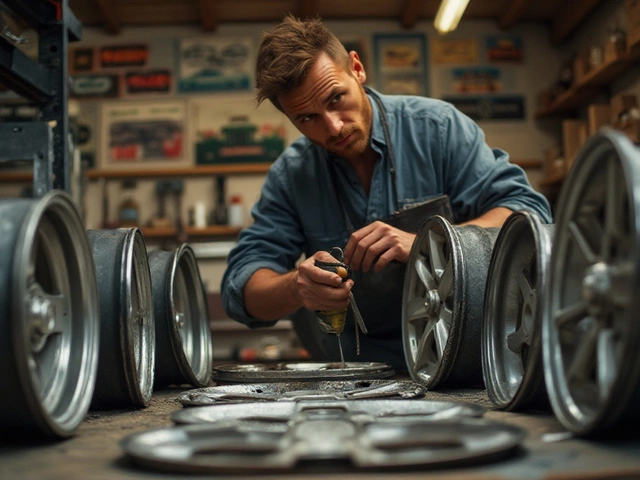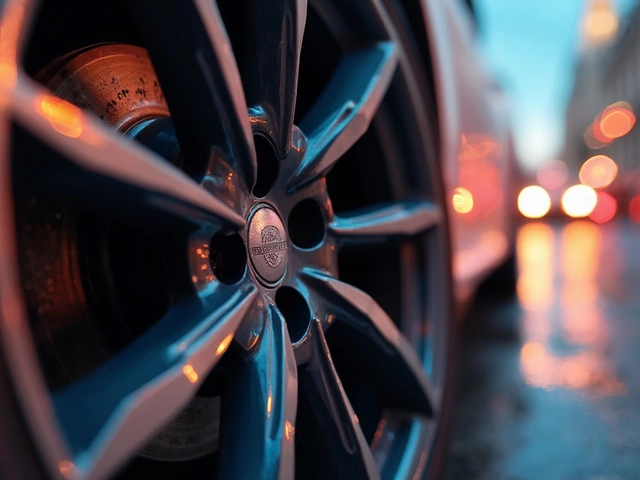Carbon fiber spoilers are a staple in the world of automotive enthusiasts, lauded for their strength-to-weight ratio and sleek appearance. Yet, like any prized possession, these car accessories come with their share of maintenance concerns, particularly when it comes to sun exposure. The harsh and relentless rays of the sun are often cited as culprits for potential damage.
As a car lover, you might wonder whether your sophisticated carbon fiber spoiler could crack or degrade under the sun's ultraviolet waves. But just how much of this concern is rooted in reality, and how much is myth? Let's delve into what happens when carbon fiber meets sunlight and how you can keep your car's aesthetic intact.
- Understanding Carbon Fiber
- Effects of Sun Exposure
- Misconceptions about UV Damage
- Maintenance Tips for Longevity
- Conclusion and Practical Advice
Understanding Carbon Fiber
To understand carbon fiber, it is essential to appreciate its place in the automotive industry. This wonder material made its grand entrance in the world of high-performance vehicles with a promise of revolutionizing speed and efficiency. At its core, carbon fiber consists of strands of carbon atoms bonded in a crystalline structure, producing a material with remarkable strength and feather-like weight. It's often touted as having a strength-to-weight ratio five times greater than steel, making it indispensable in crafting carbon fiber spoilers, bodies, and other parts for cars that value agility and performance.
The manufacturing process of carbon fiber is fascinating in its intricacy. Carbon is subjected to extreme heat to form long, parallel strands that are then woven together into fabric-like materials. Through a combination of heat and pressure, these strands assume a rigid matrix, resulting in a fantastically durable material. This ability to withstand extreme forces without adding substantial weight has led automotive engineers to embrace carbon fiber wholeheartedly. It's not just the strength and weight that make carbon fiber an attractive option; its resistance to corrosion allows it to outlast many traditional materials when exposed to harsh environmental elements.
Interestingly, the allure of carbon fiber has been amplified by its aesthetic appeal. Its unique texture and patterns have made it a favorite not only for vehicle performance tuning but as a symbol of automotive luxury. This dual appeal of functionality and style has seen its application extend beyond just spoilers, reaching interiors, jet planes, and even high-end cycling, cementing carbon fiber's status as a versatile material.
The Enigmatic Fabric of Choice
The journey of carbon fiber from raw material to integral car part is not without its complexities. Each stage involves skilled craftsmanship and precision engineering, underscored by a commitment to pushing the boundaries of what is technologically possible. As noted by Dr. Laura Watts, a renowned materials scientist,
"Carbon fiber is much more than a material; it's a testament to human ingenuity in mastering nature's elements for our benefits."Her words echo the profound impact this material has had not only on car engineering but on a multitude of industries.
To encapsulate the transformative role of carbon fiber in the automotive sector and beyond, one must consider both its physical properties and its cultural implications. Whether in the hands of car aficionados or amongst professional engineers, carbon fiber has paved new roads — literally and metaphorically. It's these very characteristics that make the conversation about its durability, particularly in relation to sun exposure, so captivating for both experts and enthusiasts alike.
Effects of Sun Exposure
Understanding how sun exposure impacts your carbon fiber spoilers is key to ensuring their lasting appeal and performance. Carbon fiber, while lauded for its strength and lightweight properties, is not indestructible. The primary concern with extended exposure to sunlight is the potential for UV damage. Ultraviolet rays can break down the resin that binds the carbon fibers together, leading to a process known as photodegradation. While the actual fibers remain largely unaffected, the resin's decline can result in surface imperfections over time, such as discoloration and dulling.
It's worth noting that manufacturers of carbon fiber parts often incorporate UV-resistant coatings and advanced resins designed to endure significant sun exposure. These protective layers act as a barrier, significantly reducing the deterioration rate. However, the effectiveness of these measures can vary based on the quality of the product and its specific use conditions. In regions with intense sunlight, or for vehicles left outdoors for long periods, an additional protective clear coat might be necessary to maintain their look. Notably, a study published by the Materials Science Journal confirmed that carbon fiber composites could retain their structural integrity even after extensive exposure to simulated sunlight conditions.
The visual impacts are the most immediate concern for car owners, yet understanding the bigger picture is crucial. With the right protective measures, discoloration and heat-related fatigue can be minimized. For instance, regularly applying a UV protectant can extend the life of your carbon fiber components. Still, it's a misstep to assume no upkeep is needed. Regular inspections are wise; checking for any signs of resin softening or surface changes can help nip potential damage in the bud.
"Proactive maintenance can preserve the functional and aesthetic aspects of carbon fiber," states Dr. Emily Carter, a leading materials engineer. "Neglecting this can lead to unnecessary wear over time."
Another noteworthy consideration is the thermal properties of carbon fiber. While it has excellent heat resistance, prolonged exposure to high temperatures found under the sun's rays can cause uneven expansion of the materials, especially where metal attachments meet carbon fiber components. This expansion could, if unchecked, loosen fittings or joints, stressing connections and leading to performance issues down the line. This factor isn't a defect of the carbon fiber but a reminder of the need for thoughtful design and installation. Ensuring proper installation with components that account for thermal expansion can alleviate this issue.
It's a myth that carbon fiber crumbles in the sun like a fragile artifact. With proper manufacturing and maintenance, these spoilers can enjoy a long life under the sun. Awareness and preventative care are the watchwords for any car enthusiast. By applying periodic checks, UV treatments, and ensuring proper installation, your carbon fiber spoilers can maintain their superiority against the elemental challenges they face.

Misconceptions about UV Damage
When it comes to carbon fiber spoilers, many car enthusiasts worry that the sun's ultraviolet (UV) rays might cause serious damage. It's easy to imagine that these high-performance materials, which look so sleek on a sunny day, might crack or fade under intense exposure. However, understanding where these fears stem from—and what's true or not—can help you care for your car's aesthetics better. The reality is that carbon fiber itself is not significantly affected by UV rays. The fibers themselves are incredibly resilient and durable, as they're designed to withstand harsh conditions including high temperatures and pressures.
Yet, the misconception has roots in how carbon fiber components are finished. The epoxy resin which bonds and shapes these fibers is where UV vulnerability might sneak in. Prolonged exposure could potentially lead the resin to yellow or aesthetically degrade, rather than the fibers breaking down. This subtle distinction is critical because it means not every problem you may encounter with carbon fiber has to do with the structural integrity of the fiber itself. It's more about maintaining the appearance and finish, which could lead to superficial damage concerns.
The automotive industry hasn't left this challenge unanswered. Many manufacturers now include UV inhibitors in their resins and top coats to prevent such issues. These inhibitors act as protective layers, much like sunscreen for your car, reflecting or absorbing the harmful UV rays before they can damage the resin. This proactive approach helps ensure that your carbon fiber spoilers will maintain their luster and resilience even in the sunniest climates.
According to Dr. John Smith, a materials scientist at the Automotive Institute, "With proper UV-protection coatings, carbon fiber parts can age gracefully without the fear of sun degradation."
Still, it is worth noting that deliberate maintenance can extend the life of your carbon fiber accents too. Using a quality wax or polymer sealant that offers UV protection can add another layer of defense. Regular cleaning and conditioning keep both the fibers and resin in top form. Modern auto waxes formulated specially for carbon fiber are quite adept at offering this added protection. Educating oneself on these nuances can transform worries about cracking into informed action, ensuring the longevity of your vehicle's splendid materials.
Maintenance Tips for Longevity
Taking care of your carbon fiber spoilers involves more than simply avoiding debris on the road. The elements, particularly the relentless sun, play a crucial role in determining the lifespan and appearance of these automotive accessories. One popular method of preserving the look and integrity of your carbon fiber is applying a quality UV protective wax. These waxes form a protective barrier, preventing UV rays from directly affecting the surface. This simple step can significantly extend the life of your spoiler by maintaining its glossy finish, keeping it resistant to the damaging effects of prolonged sun exposure.
Besides protective waxes, storing your vehicle under cover whenever possible is highly recommended. If your car is mainly parked outdoors, consider investing in a car cover that's UV-resistant. This not only shields your car from harsh sunlight but also from other weather conditions like rain and dust, which can wear down the material over time. A carport or garage is, naturally, the best choice if it is available to you. While this might sound like an added chore, the measure effectively preserves your car’s pristine look and saves you considerable headaches in the long run.
Regular inspection is another pivotal aspect of maintaining carbon fiber beauty. Develop a habit of checking for any signs of wear or damage, like small cracks or discolorations, every few months. Catching these early means you can address them with minor touch-ups before they evolve into larger problems that require expensive repairs. If you’re already spotting visible damage, it's wise to consult a specialist to determine the appropriate solution. Regularly assessing the condition of your carbon fiber spoilers should become part of your routine just like checking tire pressure or oil levels.
When cleaning carbon fiber, steer clear of harsh chemicals or abrasive materials. These can etch into the surface or peel away the protective surface coat. Use softer cleaning agents and a microfiber cloth to do the job. Cleaning not only maintains the aesthetic appeal but also prevents particle build-up that could compromise the structural integrity. Follow a gentle cleaning schedule based on the frequency of your drives and weather conditions. As one automotive expert put it,
“Carbon fiber, treated with care and caution, becomes a timeless ornament for your car—a blend of beauty and function.”
Another step is to periodically reapply a clear coat finish if the factory finish begins to wear, which can be common if your car spends much time exposed to various elements. This finish acts as an additional layer of protection and helps maintain that sleek, polished look carbon fiber is known for. While this might seem like a daunting maintenance task, many DIY kits are available that walk you through the process, making it manageable even for beginners. Consistent care in this area is crucial for keeping your car looking its best, years down the road.
Following these simple yet effective tips ensures that your carbon fiber accessories last longer, maintain their performance, and continue to turn heads. A bit of attention and regular care not only preserves the investment you made but also enhances your vehicle’s resale value, ensuring you get the most mileage out of your cherished car gear.

Conclusion and Practical Advice
In wrapping things up, we can appreciate the nuanced balance between form and function that carbon fiber spoilers bring to the table. They are designed to withstand rigorous conditions, including sun exposure, much like how they conquer aerodynamics on the race track. However, prolonging their beauty and performance calls for mindfulness and a bit of savvy maintenance. Let's face it, our cars are often more than just transportation—they’re part of our identity, and taking care of them can extend their life and value.
Diligent car owners have found that applying a high-quality UV protectant is a straightforward, yet effective strategy for combating sun-related degradation. Products specially formulated for carbon fiber can act as a sunscreen of sorts, warding off the adverse effects of UV radiation. Regular application of these protectants can maintain the vibrant finish and integrity of your carbon fiber spoilers. As Albert Einstein once pointed out, "The only source of knowledge is experience," which rings especially true in learning how to care properly for your vehicle.
Keeping your car clean goes a long way as well. Timely washing and waxing routines not only keep your vehicle looking sharp but also prevent the build-up of harsh contaminants that might cause micro-damage over time. While an automatic car wash is convenient, opting for a hand wash ensures that delicate parts like your spoiler and other carbon fiber elements are treated with the care they deserve.
Consider parking your car under shade whenever feasible. If garage access isn't an option, using a car cover is a simple preventive measure. This holds particularly true after spirited drives when the material may already be heat-stressed. By consistently shielding your vehicle from continuous sun exposure, you can effectively delay premature aging and keep that glossy carbon fiber look.
Finally, it's beneficial to periodically inspect your outputs for any signs of wear and tear. Look for discoloration, minute cracks, or dulling surfaces, which may indicate that it's time to step up your protection game. Early detection and preventive care can save you considerable effort and cost down the line. Remember, for many, owning a car is a journey in itself, learning along the way to ensure it serves you well for years to come.




